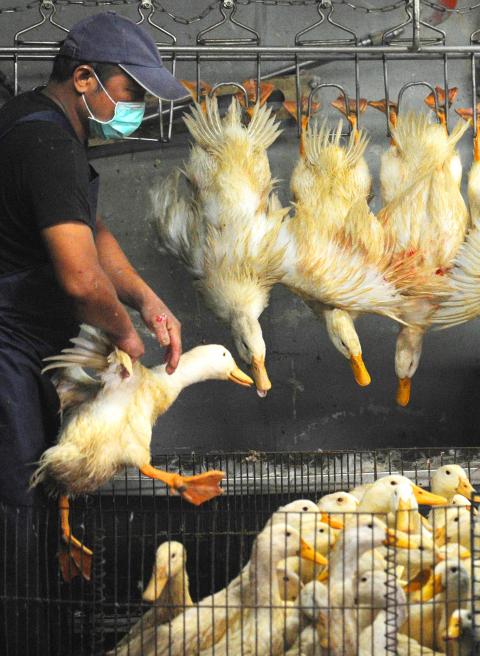The Centers for Disease Control (CDC) yesterday updated H7N9 avian influenza virus testing directives for hospitals following the first confirmed H7N9 infection in Taiwan, whose throat swab samples tested negative twice for the virus before the infection was finally confirmed via sputum specimen testing.
The Central Epidemic Command Center confirmed the first imported case of H7N9 infection in Taiwan on Wednesday, and doubts had been raised over its delayed announcement of the confirmation and the ineffective testing.
CDC Director-General Chang Feng-yee (張峰義) said the center had to undertake genome sequencing of the virus before making the confirmed case public and it is incorrect to say that throat swab testing is “ineffective.”

Photo: AFP
“The H7N9 virus was detected in the sputum sample using a real-time polymerase chain reaction [PCR] test kit. However, to be absolutely sure of the result, it is necessary to use genome sequencing, which later confirmed the infection and found that the virus strain was highly similar to the one found in Shanghai, confirming that the virus was imported,” Chang said.
“Because the throat swab samples tested negative twice after the patient was hospitalized does not mean that the testing was ineffective. There were no such pathogens in his throat. The patient developed a fever, but exhibited no respiratory or gastrointestinal symptoms when he first sought medical attention. It indicates that the virus is most active in the lower respiratory tract and the lungs,” Chang said.
CDC physician Philip Yi-chun Lo (羅一鈞) said the center now advises hospitals to obtain sputum samples from suspected cases that have coughed up phlegm, recently had pneumonia or exhibited other symptoms.
Lo said that based on the latest international research on H7N9 avian influenza, the virus’ estimated incubation period has been increased to 10 days from seven days.
“This change will affect the time needed to conduct self-health management for those who have come into close contact with an infected patient. They now have to be followed closely by health authorities until Tuesday, three days longer than the previously stated,” Lo said, adding that the three contacts who exhibited upper respiratory symptoms are recovering and all the other contacts have not exhibited any symptoms.
Meanwhile, Bureau of Animal and Plant Health Inspection and Quarantine Deputy Director Huang Kuo-ching (黃國青) said the effective date of the ban on live poultry slaughter in markets has been shifted to an earlier date of May 17, one month earlier than previously stated, as a preventive measure following the first imported H7N9 infection.
Speaking on the government’s control measures on the expected 14,000 Chinese tourists traveling to Taiwan during China’s May Day holiday, Tourism Bureau official Lin Mei-yan (林美燕) said the bureau has asked travel agencies to be on high alert on the health of tourists, and has set up a round-the-clock hotline.
“No travel restrictions will be imposed on Chinese tourists. The threshold for that kind of restriction is pretty high,” Chang said.
Officials from the Ministry of Economic Affairs (MOEA), the Ministry of Finance, the Consumer Protection Committee and the Fair Trade Commission were also present at the press conference, where it was announced that the government has been monitoring the sales of face masks and there is little concern of stock shortages.
“Local manufacturers are able to produce 800,000 masks a day, and the four major supermarket chains have only sold approximately 23,000 masks per day this month. Consumers are advised to buy masks according to their immediate needs since there is no need to stock up,” MOEA official Chen Mi-shuan (陳秘順) said.

ENDEAVOR MANTA: The ship is programmed to automatically return to its designated home port and would self-destruct if seized by another party The Endeavor Manta, Taiwan’s first military-specification uncrewed surface vehicle (USV) tailor-made to operate in the Taiwan Strait in a bid to bolster the nation’s asymmetric combat capabilities made its first appearance at Kaohsiung’s Singda Harbor yesterday. Taking inspiration from Ukraine’s navy, which is using USVs to force Russia’s Black Sea fleet to take shelter within its own ports, CSBC Taiwan (台灣國際造船) established a research and development unit on USVs last year, CSBC chairman Huang Cheng-hung (黃正弘) said. With the exception of the satellite guidance system and the outboard motors — which were purchased from foreign companies that were not affiliated with Chinese-funded

PERMIT REVOKED: The influencer at a news conference said the National Immigration Agency was infringing on human rights and persecuting Chinese spouses Chinese influencer “Yaya in Taiwan” (亞亞在台灣) yesterday evening voluntarily left Taiwan, despite saying yesterday morning that she had “no intention” of leaving after her residence permit was revoked over her comments on Taiwan being “unified” with China by military force. The Ministry of the Interior yesterday had said that it could forcibly deport the influencer at midnight, but was considering taking a more flexible approach and beginning procedures this morning. The influencer, whose given name is Liu Zhenya (劉振亞), departed on a 8:45pm flight from Taipei International Airport (Songshan airport) to Fuzhou, China. Liu held a news conference at the airport at 7pm,

AIR SUPPORT: The Ministry of National Defense thanked the US for the delivery, adding that it was an indicator of the White House’s commitment to the Taiwan Relations Act Deputy Minister of National Defense Po Horng-huei (柏鴻輝) and Representative to the US Alexander Yui on Friday attended a delivery ceremony for the first of Taiwan’s long-awaited 66 F-16C/D Block 70 jets at a Lockheed Martin Corp factory in Greenville, South Carolina. “We are so proud to be the global home of the F-16 and to support Taiwan’s air defense capabilities,” US Representative William Timmons wrote on X, alongside a photograph of Taiwanese and US officials at the event. The F-16C/D Block 70 jets Taiwan ordered have the same capabilities as aircraft that had been upgraded to F-16Vs. The batch of Lockheed Martin

GRIDLOCK: The National Fire Agency’s Special Search and Rescue team is on standby to travel to the countries to help out with the rescue effort A powerful earthquake rocked Myanmar and neighboring Thailand yesterday, killing at least three people in Bangkok and burying dozens when a high-rise building under construction collapsed. Footage shared on social media from Myanmar’s second-largest city showed widespread destruction, raising fears that many were trapped under the rubble or killed. The magnitude 7.7 earthquake, with an epicenter near Mandalay in Myanmar, struck at midday and was followed by a strong magnitude 6.4 aftershock. The extent of death, injury and destruction — especially in Myanmar, which is embroiled in a civil war and where information is tightly controlled at the best of times —